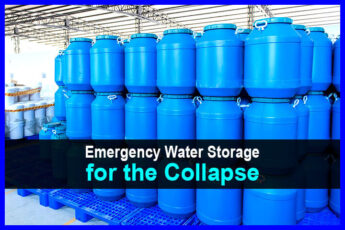Estimated reading time: 8 minutes
As climate change accelerates, droughts are becoming longer and more common. The Western United States is currently experiencing its worst drought in 1200 years, and Europe is experiencing one of its worst droughts ever.
As a result, bodies of water all over the world are drying up. It's particularly bad in North America, where the Great Salt Lake may soon dry up completely, leaving behind a toxic dustbowl. Meanwhile, the Colorado river, which supplies drinking water to 40 million people, is drying up as well.
There could come a day when there simply isn't enough water for cities and local governments to provide tap water to their citizens. If you think that's unrealistic, it's already happened in villages all across India and in cities such as Monterrey, Mexico, where citizens rely on bottled water and government water tankers. This is what happens when drought never ends.
But even if your city never runs out of water, it still needs a functioning infrastructure and power grid in order to purify the water and pump it into the water towers. If the grid goes down for an extended period of time, eventually the water towers will be empty, and your faucets will be useless.
In an age of megadroughts and extreme heatwaves, knowing how to collect water is crucial. Here are some ways to collect water in a crisis.
Want to save this post for later? Click Here to Pin It On Pinterest!
In the home
Many of us are accustomed to simply turning on a faucet when we need a drink. But what happens when nothing comes out of the tap or that supply is tainted? Here are some home sources you might not have considered.
1. Ice
You can melt the ice cubes you have in your freezer for some clean drinking water.
2. Hot Water Heater
Depending on your tank’s size, you may have 20 to 80 gallons of water stored there. In order to access it safely, you’ll need to know whether it is gas- or electric-powered and follow the instructions for your particular model.
The critical first step is to turn off the power supply and shut off the water. Here is a video that goes over the basics for draining the water.
3. Toilet Flush Tank
You may have three to five gallons of water in your toilet flush tank. You can drink this water, but be sure to purify it first as it could have contaminants from the sewer. It’s not recommended to drink the water in the toilet bowl—even if it was recently flushed—since it may be contaminated by residual bacteria.
4. Household Pipes
You can use the force of gravity to drain water that is in your home’s plumbing system even after the main supply flow has stopped.
Turn on the highest water faucet in your house to introduce air into the pipe. Place a container beneath the lowest faucet in the home. Turn on that faucet to drain out the water.
If you live in a one-story home, you may find that the highest faucet is your shower head and a hose spigot is your lowest. The water valve may be in a common area if you live in an apartment or condominium. The amount of available water will depend on your home’s location and how many other people are draining the pipes.
Outside the home
You also can find emergency water sources outside your home. These sources are more susceptible to contamination and should be treated by boiling, adding disinfectants, or using a filter.
5. Rainwater
Collecting rainwater can run the gamut from using a simple rain barrel to installing a catchment system.
The main thing to remember is that you need to use clean, covered collection containers. Any water that hits the ground (or a dirty barrel) can become contaminated.
Also, if you collect rainwater from the roof, it could contain anything from bird poop and insects to asbestos, lead, and copper. Recent studies have shown that “forever chemicals” are omnipresent in the world’s rainwater. So, you probably will want to purify your rainwater before drinking to eliminate what you can.
6. Hose and Sprinkler Systems
You might be surprised to find out how much water remains in your watering hoses and irrigation systems. But beware. Most hoses are manufactured with polyvinyl chloride (PVC) that uses lead as a stabilizer. Also, the brass fitting on the ends of the hoses may contain lead.
7. Transpiration
It’s a slow process that doesn’t yield an ample water supply. But in an emergency, every drop counts. You can extract water from plants by placing a clear plastic bag over the branch of a bush or tree growing in a sunny location.
Water will begin to condense on the sides of the bag in as little as an hour. After about five hours, you may collect as much as a half-cup of water.
Note: Take care of what bags you use. Many plastic bags will release toxins into the water. This article explains the process.
8. Solar Stills
A solar still relies on evaporation and condensation to produce distilled water. This article explains the process. However, you’ll need multiple systems are required to produce a large quantity of distilled water. This video shows how much time and work it takes to have a small amount of distilled water.
9. Wells
Digging a well on your property is perhaps the most sustainable way to have an emergency supply of water. How deep you need to dig depends on your location.
Experts tend to agree that a drilled well is a better choice than a dug well. Dug wells usually only reach the top of the water table, meaning they can dry up as the water table fluctuates.
On the other hand, drilled wells reach deeper into the earth and make use of a submersible pump at the bottom to get the water out.
In the Wilderness
Other sources of water can be found in natural settings.
10. Bodies of Water
It’s evident that freshwater ponds, lakes, rivers, and streams can be life savers when you need water. Look for fast-flowing water at higher elevations for the cleanest water. And check to make sure the water is away from possible wastewater contamination from humans or livestock.
If you can’t locate water, here are a few signs to look for:
- Animal trails
- Low-flying birds
- Insect activity
11. Snow
In the winter, you can melt snow and ice as another water source. This video shows three methods you can use.
12. Morning Dew
Depending on the time of year and your location, you may be able to harvest the morning dew to quench your thirst. Try tying a bandana or a t-shirt around your ankle and walking through the dewy landscape. You can wring the moisture into a jar or into your mouth. This video shows how easy the process is.
13. Plants
Some plants have a high water content. This article details some of the do’s and don’ts when it comes to getting water from plants in a survival situation.
Water for Other Purposes
Although we need to drink water in order to survive, we also rely on water for our gardens and for sanitary purposes. Here are some sources of water you may be able to use for other purposes, reserving fresh water for cooking and drinking.
- Pools and spas
- Radiators
- Water beds
- Hot water boilers (part of the home heating system)
How to Purify Water
Although removing all the chemicals from our water may be impossible, the following methods are standard ways to purify water.
- Boiling. Filter water through a clean paper towel, coffee filter, or cloth. Then, bring the filtered water to a rolling boil for at least three minutes. Cover water and allow it to cool before drinking.
- Tincture of iodine. Add five drops of tincture of iodine to one quart of clear, strained water (or 10 drops to one quart of cloudy water). Mix well and allow water to stand for 30 minutes before drinking.
- Purification tablets. Water purification tablets are available online and in brick-and-mortar stores. They are small, lightweight, and effective.
- Bleach. Liquid household bleach that contains 6 percent hypochlorite is suitable for water purification. Do not use scented bleach, and do not use bleach that you purchased more than six months ago. Read the product label for the correct proportions.
- Portable water filter. Portable water filters are a good choice for backpacks and bug-out bags.
For more information on water purification, here are some helpful resources.
- Ways to Purify Water
- Guide to Water Purification
- Emergency Disinfection of Drinking Water
- Drinking Water Purification Methods
We never know when our water supply could suddenly be curtailed. Road work and construction can damage water mains. Severe storms or earthquakes can destroy infrastructure. And, as have seen recently in the warfare Russia is waging on Ukraine, public utilities can be on the causality list.
For these and other reasons, the time to plan for water scarcity is now. For example, look for nearby freshwater sources and become accustomed to using purification methods. Another critical measure is to store enough water to last each member of your family for at least three days.
The Centers for Disease Control (CDC) recommends storing a minimum of one gallon of water per person per day for three days for drinking and sanitation—and a two-week supply if possible.
Like this post? Don't Forget to Pin It On Pinterest!






